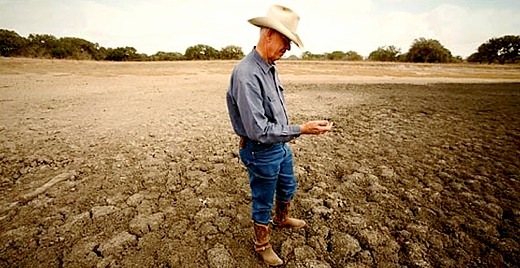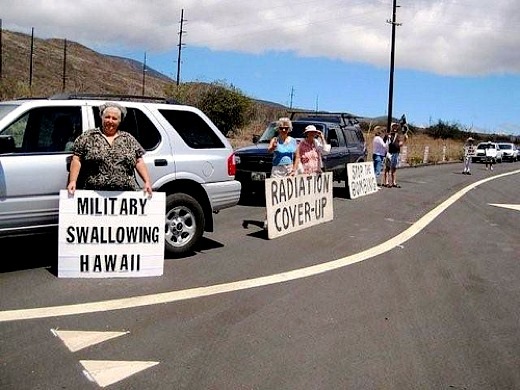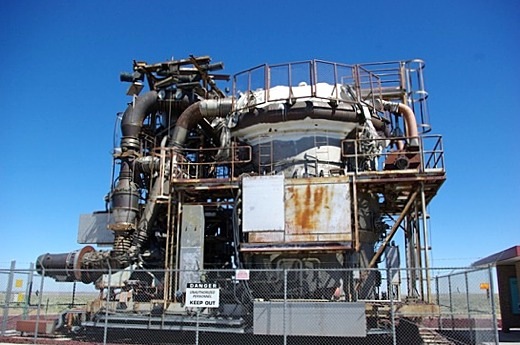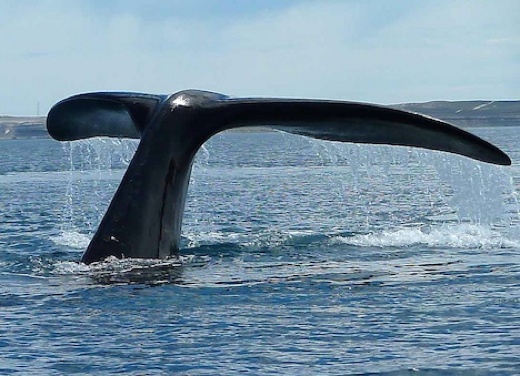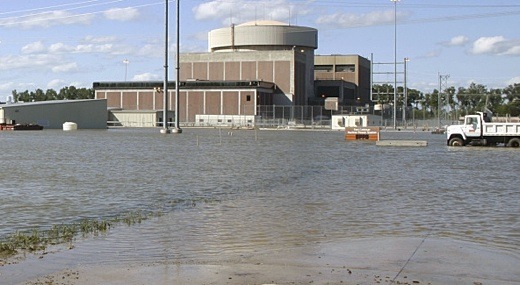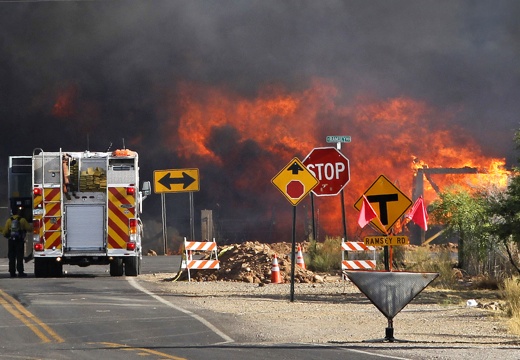SUBHEAD: Scientists say Monsanto's popular herbicide, linked to GMO products, causes birth defects in mammals.
By Lucia Graves on 24 June 2011 for Huffington Post -
(http://www.huffingtonpost.com/2011/06/24/roundup-scientists-birth-defects_n_883578.html)
 Image above: Commercial spraying of RoundUp on food crops genetically designed to withstand the herbicide is prevalent. From (http://indianapublicmedia.org/eartheats/effects-gm-pesticide-products).
Image above: Commercial spraying of RoundUp on food crops genetically designed to withstand the herbicide is prevalent. From (http://indianapublicmedia.org/eartheats/effects-gm-pesticide-products).
The chemical at the heart of the planet’s most widely used herbicide -- Roundup weedkiller, used in farms and gardens across the U.S. -- is coming under more intense scrutiny following the release of a new report calling for a heightened regulatory response around its use.
Critics have argued for decades that glyphosate, the active ingredient in Roundup and other herbicides used around the globe, poses a serious threat to public health. Industry regulators, however, appear to have consistently overlooked their concerns.
A comprehensive review of existing data released this month by Earth Open Source, an organization that uses open-source collaboration to advance sustainable food production, suggests that industry regulators in Europe have known for years that glyphosate, originally introduced by American agricultural biotechnology giant Monsanto in 1976, causes birth defects in the embryos of laboratory animals.
Founded in 2009, Earth Open Source is a non-profit organization incorporated in the U.K. but international in scope. Its three directors, specializing in business, technology and genetic engineering, work pro-bono along with a handful of young volunteers. Partnering with half a dozen international scientists and researchers, the group drew its conclusions in part from studies conducted in a number of locations, including Argentina, Brazil, France and the United States.
Earth Open Source’s study is only the latest report to question the safety of glyphosate, which is the top-ranked herbicide used in the United States. Exact figures are hard to come by because the U.S. Department of Agriculture stopped updating its pesticide use database in 2008. The EPA estimates that the agricultural market used 180 to 185 million pounds of glyphosate between 2006 and 2007, while the non-agricultural market used 8 to 11 million pounds between 2005 and 2007, according to its Pesticide Industry Sales & Usage Report for 2006-2007 published in February, 2011.
The Earth Open Source study also reports that by 1993 the herbicide industry, including Monsanto, knew that visceral anomalies such as dilation of the heart could occur in rabbits at low and medium-sized doses. The report further suggests that since 2002, regulators with the European Commission have known that glyphosate causes developmental malformations in lab animals.
Even so, the commission’s health and consumer division published a final review report of glyphosate in 2002 that approved its use in Europe for the next 10 years.
As recently as last year, the German Federal Office for Consumer Protection and Food Safety (BLV), a government agency conducting a review of glyphosate, told the European Commission that there was no evidence the compound causes birth defects, according to the report.
The agency reached that conclusion despite almost half a dozen industry studies that found glyphosate produced fetal malformations in lab animals, as well as an independent study from 2007 that found that Roundup induces adverse reproductive effects in the male offspring of a certain kind of rat.
German regulators declined to respond in detail for this story because they say they only learned of the Earth Open Source report last week. The regulators emphasized that their findings were based on public research and literature.
Although the European Commission originally planned to review glyphosate in 2012, it decided late last year not to do so until 2015. And it won’t review the chemical under more stringent, up-to-date standards until 2030, according to the report.
The European Commission told HuffPost that it wouldn’t comment on whether it was already aware of studies demonstrating the toxicity of glyphosate in 2002. But it said the commission was aware of the Earth Open Source study and had discussed it with member states.
“Germany concluded that study does not change the current safety assessment of gylphosate,” a commission official told HuffPost in an email. “This view is shared by all other member states.”
John Fagan, a doctor of molecular and cell biology and biochemistry and one of the founders of Earth Open Source, acknowledged his group’s report offers no new laboratory research. Rather, he said the objective was for scientists to compile and evaluate the existing evidence and critique the regulatory response.
“We did not do the actual basic research ourselves,” said Fagan. “The purpose of this paper was to bring together and to critically evaluate all the evidence around the safety of glyphosate and we also considered how the regulators, particularly in Europe, have looked at that.”
For its part, Earth Open Source said that government approval of the ubiquitous herbicide has been rash and problematic.
"Our examination of the evidence leads us to the conclusion that the current approval of glyphosate and Roundup is deeply flawed and unreliable," wrote the report’s authors. "What is more, we have learned from experts familiar with pesticide assessments and approvals that the case of glyphosate is not unusual.
"They say that the approvals of numerous pesticides rest on data and risk assessments that are just as scientifically flawed, if not more so," the authors added. "This is all the more reason why the Commission must urgently review glyphosate and other pesticides according to the most rigorous and up-to-date standards."
Monsanto spokeswoman Janice Person said in a statement that the Earth Open Source report presents no new findings.
"Based on our initial review, the Earth Open Source report does not appear to contain any new health or toxicological evidence regarding glyphosate,” Person said.
“Regulatory authorities and independent experts around the world agree that glyphosate does not cause adverse reproductive effects in adult animals or birth defects in offspring of these adults exposed to glyphosate," she said, "even at doses far higher than relevant environmental or occupational exposures.”
While Roundup has been associated with deformities in a host of laboratory animals, its impact on humans remains unclear. One laboratory study done in France in 2005 found that Roundup and glyphosate caused the death of human placental cells. Another study, conducted in 2009, found that Roundup caused total cell death in human umbilical, embryonic and placental cells within 24 hours. Yet researchers have conducted few follow-up studies.
“Obviously there’s a limit to what’s appropriate in terms of testing poison on humans,” said Jeffrey Smith, executive director of the Institute for Responsible Technology, which advocates against genetically modified food. “But if you look at the line of converging evidence, it points to a serious problem. And if you look at the animal feeding studies with genetically modified Roundup ready crops, there’s a consistent theme of reproductive disorders, which we don’t know the cause for because follow-up studies have not been done.”
“More independent research is needed to evaluate the toxicity of Roundup and glyphosate,” he added, “and the evidence that has already accumulated is sufficient to raise a red flag.”
Authorities have criticized Monsanto in the past for soft-pedaling Roundup. In 1996 New York State's Attorney General sued Monsanto for describing Roundup as "environmentally friendly" and "safe as table salt." Monsanto, while not admitting any wrongdoing, agreed to stop using the terms for promotional purposes and paid New York state $250,000 to settle the suit.
Regulators in the United States have said they are aware of the concerns surrounding glyphosate. The Environmental Protection Agency, which is required to reassess the safety and effectiveness all pesticides on a 15-year cycle through a process called registration review, is currently examining the compound.
“EPA initiated registration review of glyphosate in July 2009,” the EPA told HuffPost in a written statement. “EPA will determine if our previous assessments of this chemical need to be revised based on the results of this review. EPA issued a notice to the company [Monsanto] to submit human health and ecotoxicity data in September 2010.”
The EPA said it will also review a “wide range of information and data from other independent researchers” including Earth Open Source.
The agency's Office of Pesticide Programs is in charge of the review and has set a deadline of 2015 for determining if registration modifications need to be made or if the herbicide should continue to be sold at all.
Though skirmishes over the regulation of glyphosate are playing out at agencies across the U.S. and around the world, Argentina is at the forefront of the battle.
THE ARGENTINE MODEL
The Earth Open Source report, "Roundup and birth defects: Is the public being kept in the dark?" comes years after Argentine scientists and residents targeted glyphosate, arguing that it caused health problems and environmental damage.
Farmers and others in Argentina use the weedkiller primarily on genetically modified Roundup Ready soy, which covers nearly 50 million acres, or half of the country's cultivated land area. In 2009 farmers sprayed that acreage with an estimated 200 million liters of glyphosate.
The Argentine government helped pull the country out of a recession in the 1990s in part by promoting genetically modified soy. Though it was something of a miracle for poor farmers, several years after the first big harvests residents near where the soy cop grew began reporting health problems, including high rates of birth defects and cancers, as well as the losses of crops and livestock as the herbicide spray drifted across the countryside.
Such reports gained further traction after an Argentine government scientist, Andres Carrasco conducted a study, "Glyphosate-Based Herbicides Produce Teratogenic Effects on Vertebrates by Impairing Retinoic Acid Signaling" in 2009.
The study, published in the journal Chemical Research in Toxicology in 2010, found that glyphosate causes malformations in frog and chicken embryos at doses far lower than those used in agricultural spraying. It also found that malformations caused in frog and chicken embryos by Roundup and its active ingredient glyphosate were similar to human birth defects found in genetically modified soy-producing regions.
"The findings in the lab are compatible with malformations observed in humans exposed to glyphosate during pregnancy," wrote Carrasco, director of the Laboratory of Molecular Embryology at the University of Buenos Aires. "I suspect the toxicity classification of glyphosate is too low.”
“In some cases this can be a powerful poison," he concluded.
Argentina has not made any federal reforms based on this research and has not discussed the research publicly, Carrasco told HuffPost, except to mount a "close defense of Monsanto and it partners."
The Ministry of Science and Technology has moved to distance the government from the study, telling media at the time the study was not commissioned by the government and had not been reviewed by scientific peers.
Ignacio Duelo, spokesman for the the Ministry of Science and Technology’s National Council for Scientific and Technical Research [CONICET], told HuffPost in an statement that while Carrasco is one of its researchers, CONICET has not vouched for or assessed his work.
Duelo said that the Ministry of Science is examining Carrasco’s report as part of a study of the possible harmful effects of the glyphosate. Officials, he added, are as yet unable to “reach a definitive conclusion on the effects of glyphosate on human health, though more studies are recommended, as more data is necessary.”
REGIONAL BANS
After Carrasco announced his findings in 2009, the Defense Ministry banned planting of genetically modified glyphosate-resistant soy on lands it rents to farmers, and a group of environmental lawyers petitioned the Supreme Court of Argentina to implement a national ban on the use of glyphosate, including Monsanto's Roundup product. But the ban was never adopted.
"A ban, if approved, would mean we couldn't do agriculture in Argentina," said Guillermo Cal, executive director of CASAFE, Argentina's association of fertilizer companies, in a statement at the time.
In March 2010, a regional court in Argentina's Santa Fe province banned the spraying of glyphosate and other herbicides near populated areas. A month later, the provincial government of Chaco province issued a report on health statistics from La Leonesa. The report, which was carried in the leftist Argentinian newspaper Página 12, showed that from 2000 to 2009, following the expansion of genetically-modified soy and rice crops in the region, the childhood cancer rate tripled in La Leonesa and the rate of birth defects increased nearly fourfold over the entire province.
MORE QUESTIONS
Back in the United States, Don Huber, an emeritus professor of plant pathology at Purdue University, found that genetically-modified crops used in conjunction with Roundup contain a bacteria that may cause animal miscarriages.
After studying the bacteria, Huber wrote Secretary of Agriculture Tom Vilsack in February warning that the "pathogen appears to significantly impact the health of plants, animals, and probably human beings."
The bacteria is particularly prevalent in corn and soybean crops stricken by disease, according to Huber, who asked Vilsack to stop deregulating Roundup Ready crops. Critics such as Huber are particularly wary of those crops because scientists have genetically altered them to be immune to Roundup -- and thus allow farmers to spray the herbicide liberally onto a field, killing weeds but allowing the crop itself to continue growing.
Monsanto is not the only company making glyphosate. China sells glyphosate to Argentina at a very low price, Carrasco said, and there are more than one hundred commercial formulations in the market. But Monsanto’s Roundup has the longest list of critics, in part because it dominates the market.
The growth in adoption of genetically modified crops has exploded since their introduction in 1996. According to Monsanto, an estimated 89 percent of domestic soybean crops were Roundup Ready in 2010, and as of 2010, there were 77.4 million acres of Roundup Ready soybeans planted, according to the Department of Agriculture.
In his letter to the Agriculture Department, Huber also commented on the herbicide, saying that the bacteria that he’s concerned about appears to be connected to use of glyphosate, the key ingredient in Roundup.
"It is well-documented that glyphosate promotes soil pathogens and is already implicated with the increase of more than 40 plant diseases; it dismantles plant defenses by chelating vital nutrients; and it reduces the bioavailability of nutrients in feed, which in turn can cause animal disorders," he wrote.
Huber said the Agriculture Department wrote him in early May and that he has had several contacts with the agency since then. But there’s little evidence that government officials have any intention of conducting the “multi-agency investigation” Huber requested.
Part of the problem may be that the USDA oversees genetically modified crops while the EPA watches herbicides, creating a potential regulatory loophole for products like Roundup, which relies on both to complete the system. When queried, USDA officials emphasized that they do not regulate pesticides or herbicides and declined to comment publicly on Huber's letter.
A spokesman eventually conceded their scientists do study glyphosate. "USDA’s Agricultural Research Service’s research with glyphosate began shortly after the discovery of its herbicidal activity in the mid 1970s," said the USDA in a statement. "All of our research has been made public and much has gone through the traditional peer review process.”
While Huber acknowledged his research is far from conclusive, he said regulatory agencies must seek answers now. “There is much research that needs to be done yet,” he said. “But we can't afford to wait the three to five years for peer-reviewed papers.”
While Huber’s claims have roiled the agricultural world and the blogosphere alike, he has fueled skeptics by refusing to make his research public or identify his fellow researchers, who he claims could suffer substantial professional backlash from academic employers who received research funding from the biotechnology industry.
At Purdue University, six of Huber’s former colleagues pointedly distanced themselves from his findings, encouraging crop producers and agribusiness personnel “to speak with University Extension personnel before making changes in crop production practices that are based on sensationalist claims.”
Since it first introduced the chemical to the world in the 1970s, Monsanto has netted billions on its best-selling herbicide, though the company has faced stiffer competition since its patent expired in 2000 and it is reportedly working to revamp its strategy.
In a lengthy email, Person, the Monsanto spokeswoman, responded to critics, suggesting that the economic and environmental benefits of Roundup were being overlooked:
The authors of the report create an account of glyphosate toxicity from a selected set of scientific studies, while they ignored much of the comprehensive data establishing the safety of the product. Regulatory agencies around the world have concluded that glyphosate is not a reproductive toxin or teratogen (cause of birth defects) based on in-depth review of the comprehensive data sets available. Earth Open Source authors take issue with the decision by the European Commission to place higher priority on reviewing other pesticide ingredients first under the new EU regulations, citing again the flawed studies as the rationale. While glyphosate and all other pesticide ingredients will be reviewed, the Commission has decided that glyphosate appropriately falls in a category that doesn’t warrant immediate attention.
“The data was there but the regulators were glossing over it," said John Fagan of Earth Open Source, "and as a result it was accepted in ways that we consider really questionable.”
CORNERING THE INDUSTRY?
Although the EPA has said it wants to evaluate more evidence of glyphosate's human health risk as part of a registration review program, the agency is not doing any studies of its own and is instead relying on outside data -- much of which comes from the agricultural chemicals industry it seeks to regulate.
"EPA ensures that each registered pesticide continues to meet the highest standards of safety to protect human health and the environment," the agency told HuffPost in a statement. "These standards have become stricter over the years as our ability to evaluate the potential effects of pesticides has increased. The Agency placed glyphosphate into registration review. Registration review makes sure that as the ability to assess risks and as new information becomes available, the Agency carefully considers the new information to ensure pesticides do not pose risks of concern to people or the environment."
Agribusiness giants, including Monsanto, Dow Chemical, Syngenta and BASF, will, as part of a 19-member task force, generate much of the data the EPA is seeking. But the EPA has emphasized that the task force is only “one of numerous varied third-party sources that EPA will rely on for use in its registration review.”
The EPA is hardly the only industry regulator that relies heavily on data supplied by the agrochemical industry itself.
“The regulation of pesticides has been significantly skewed towards the manufacturers interests where state-of-the-art testing is not done and adverse findings are typically distorted or denied,” said Jeffrey Smith, of the Institute for Responsible Technology. “The regulators tend to use the company data rather than independent sources, and the company data we have found to be inappropriately rigged to force the conclusion of safety.”
“We have documented time and time again scientists who have been fired, stripped of responsibilities, denied funding, threatened, gagged and transferred as a result of the pressure put on them by the biotech industry,” he added.
Such suppression has sometimes grown violent, Smith noted. Last August, when Carrasco and his team of researchers went to give a talk in La Leonesa they were intercepted by a mob of about a hundred people. The attack landed two people in the hospital and left Carrasco and a colleague cowering inside a locked car. Witnesses said the angry crowd had ties to powerful economic interests behind the local agro-industry and that police made little effort to interfere with the beating, according to the human rights group Amnesty International.
Fagan told HuffPost that among developmental biologists who are not beholden to the chemical industry or the biotechnology industry, there is strong recognition that Carrasco’s research is credible.
"For me as a scientist, one of the reasons I made the effort to do this research into the literature was to really satisfy the question myself as to where the reality of the situation lies,” he added. “Having thoroughly reviewed the literature on this, I feel very comfortable in standing behind the conclusions Professor Carrasco came to and the broader conclusions that we come to in our paper
“We can’t figure out how regulators could have come to the conclusions that they did if they were taking a balanced look at the science, even the science that was done by the chemical industry itself.”
.
